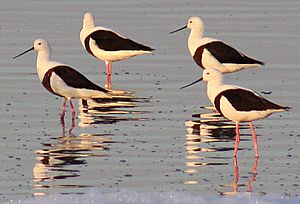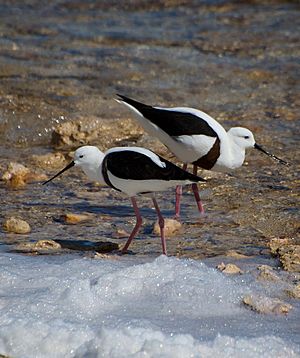Banded Stilt facts for kids
Quick facts for kids Banded Stilt |
|
|---|---|
 |
|
| Banded Stilts, Governors Lake, Rottnest Island |
|
| Conservation status | |
| Scientific classification | |
| Kingdom: | |
| Phylum: | |
| Class: | |
| Order: | |
| Family: | |
| Genus: |
Cladorhynchus
Gray,GR, 1840
|
| Species: |
C. leucocephalus
|
| Binomial name | |
| Cladorhynchus leucocephalus |
|
The banded stilt (Cladorhynchus leucocephalus) is a special water bird from Australia. It's known for traveling a lot, especially to find the perfect places to live and have its babies. These birds are a type of wader, which means they often walk in shallow water to find food.
Contents
What do they look like?
This bird gets its name from a cool red-brown band across its chest. You can see this band clearly when the birds are ready to breed. When they are not breeding, or if they are young birds, this band might be faded or even missing. The rest of their feathers are a mix of black and white, which is called "pied." Their eyes are a dark brown.
Banded stilts stand about 35 to 45 centimeters (14 to 18 inches) tall. People sometimes call them the "Flamingo of Australia" because of their long legs and how they look in the water. On Rottnest Island, they are sometimes called the "Rottnest snipe," even though they are not related to true snipes.
Where do they live and breed?
Banded stilts spend a lot of their time near the coast. They can be found in places where rivers meet the sea (called estuaries) and on flat areas of land that are covered by the tide.
But here's a cool fact: they travel to the desert to breed! They only do this when there's enough water. They lay 3 to 4 eggs that can be white, brown, or black. They make their nests by scraping a small dip in the sand.
Banded stilts choose islands that form when dry salt lakes fill up with water after a big flood. They come to these lakes to eat tiny creatures called brine shrimp, especially a type called Paratemia. The eggs of these shrimp can stay in the dry lake beds for many years, just waiting for the rain to fall.

Amazing Breeding Events
Over the last 200 years, since Europeans first settled in Australia, banded stilts have only been recorded breeding about 20 times. This shows how special and rare these breeding events are!
In South Australia, where these stilts are considered a vulnerable species (meaning they are at risk), they have only bred seven times in the last 70 years.
In 2010, something amazing happened at Lake Torrens National Park. More than 150,000 banded stilts gathered there to breed! The lake had filled with water for only the second time in 150 years, creating the perfect spot for them.
However, it's not always easy for the baby stilts. Their eggs and chicks are often eaten by other birds, like silver gulls. For example, in 2000, when the stilts were breeding on Lake Eyre, almost all the chicks were eaten by gulls.
Images for kids
-
A colony of banded stilts, Coorong, South Australia; some red-necked avocets can be seen at far right.
See also
 In Spanish: Cigüeñuela pechirroja para niños
In Spanish: Cigüeñuela pechirroja para niños





